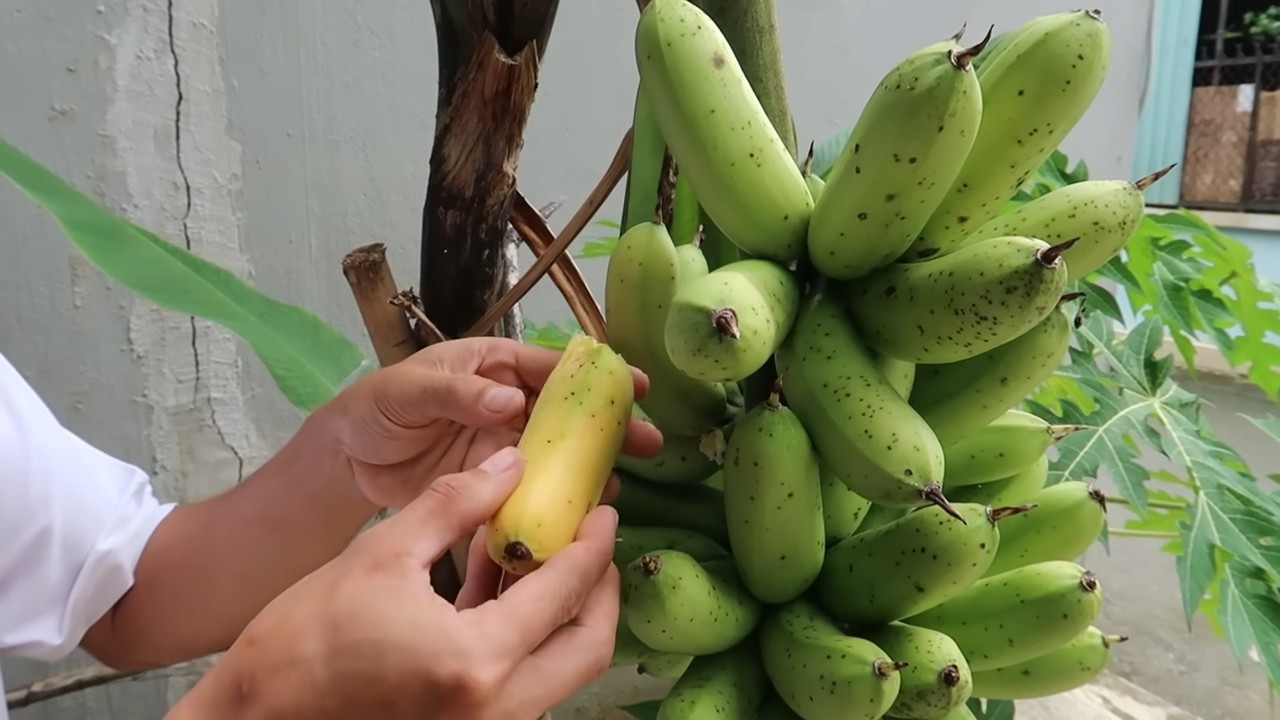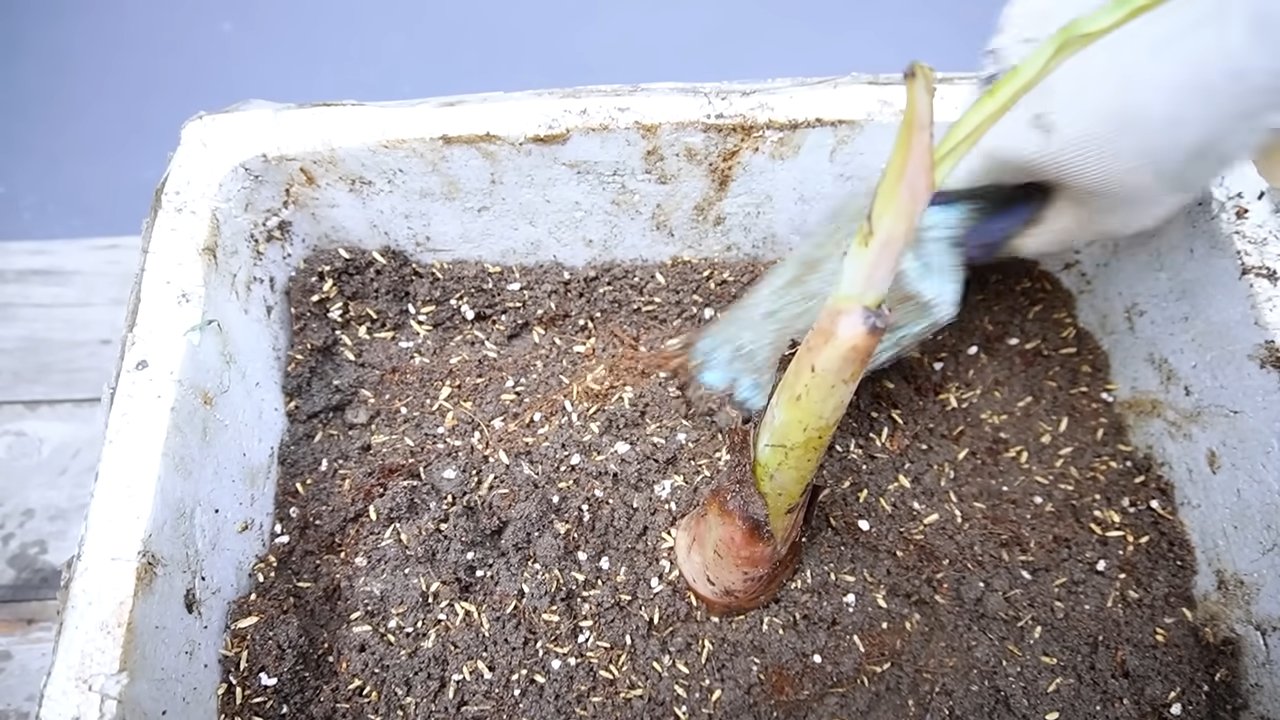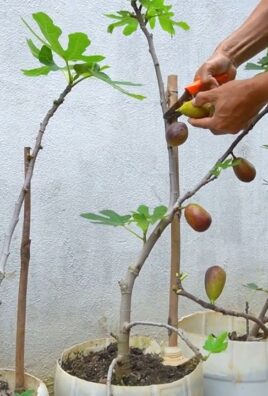Growing bananas at home might sound like a tropical dream reserved for sun-drenched plantations, but I’m here to tell you it’s more achievable than you think! Forget those expensive grocery store bunches – imagine plucking your own sweet, creamy bananas right from your backyard. This DIY guide is your passport to a miniature banana republic, right in your own home.
Bananas have a rich history, deeply intertwined with cultures across the globe. Originating in Southeast Asia, they’ve been cultivated for thousands of years, becoming a staple food and a symbol of prosperity in many societies. From ancient medicinal uses to modern-day smoothies, the banana’s journey is truly remarkable.
But why should you bother with the effort of growing bananas at home? Well, beyond the sheer satisfaction of nurturing your own food source, it’s about having access to fresher, potentially organic fruit. Plus, it’s a fantastic conversation starter! Let’s be honest, who wouldn’t be impressed by a friend who can casually offer a homegrown banana? This DIY trick will help you understand the basics of growing bananas at home, from choosing the right variety to providing the perfect growing conditions. So, grab your gardening gloves, and let’s embark on this exciting adventure together!

Growing Bananas at Home: A DIY Guide to Tropical Delights
Hey there, fellow plant enthusiasts! Ever dreamt of harvesting your own bananas right in your backyard? It might sound like a tropical fantasy, but with a little know-how and some patience, you can absolutely grow bananas at home, even if you don’t live in the tropics! I’m going to walk you through everything you need to know, from choosing the right variety to harvesting your delicious, homegrown bananas.
Choosing the Right Banana Variety
First things first, not all banana varieties are created equal, especially when it comes to growing them outside of their ideal climate. You’ll want to pick a variety that’s known for being relatively cold-hardy or dwarf, making it easier to manage in smaller spaces. Here’s a breakdown of some popular choices:
* Dwarf Cavendish: This is probably the most common variety you’ll find. It’s relatively small (hence the “dwarf” part), produces good-sized bananas, and is somewhat tolerant of cooler temperatures.
* Rajapuri: Another dwarf variety that’s known for its sweet, creamy bananas. It’s also fairly cold-hardy.
* Ice Cream (Blue Java): This one’s a bit more unique! It produces bananas with a slightly bluish tint and a flavor that some say resembles vanilla ice cream. It’s moderately cold-hardy.
* Orinoco: This variety is known for its exceptional cold hardiness compared to other bananas. The fruits are shorter and thicker than Cavendish.
Important Considerations:
* Your Climate: Research the average minimum temperatures in your area. This will help you determine which varieties are most likely to thrive.
* Space: Consider how much space you have available. Dwarf varieties are obviously better suited for smaller gardens or container growing.
* Taste Preference: Do a little research on the flavor profiles of different varieties to find one that appeals to you.
Getting Started: Planting Your Banana Plant
Okay, you’ve chosen your banana variety – awesome! Now it’s time to get your hands dirty. Here’s how to plant your banana plant:
1. Choosing the Right Location: Bananas need plenty of sunlight – at least 6-8 hours per day. They also prefer well-draining soil that’s rich in organic matter. If you’re planting in the ground, choose a spot that’s sheltered from strong winds, as the large leaves can be easily damaged. If you’re planting in a container, make sure it’s large enough to accommodate the plant’s root system (at least 20 gallons).
2. Preparing the Soil: Whether you’re planting in the ground or in a container, it’s important to prepare the soil properly. Amend the soil with plenty of compost, aged manure, or other organic matter. This will help improve drainage, fertility, and water retention. A slightly acidic soil pH (around 6.0-6.5) is ideal.
3. Planting the Banana Plant: Dig a hole that’s slightly larger than the root ball of your banana plant. Gently remove the plant from its container and loosen any circling roots. Place the plant in the hole, making sure the top of the root ball is level with the surrounding soil. Backfill the hole with soil and gently firm it down.
4. Watering: Water the newly planted banana plant thoroughly. Keep the soil consistently moist, but not waterlogged.
Caring for Your Banana Plant
Now that your banana plant is in the ground (or container), it’s time to provide it with the care it needs to thrive.
1. Watering: Bananas are thirsty plants! Water them regularly, especially during hot, dry weather. The soil should be consistently moist, but not soggy. Overwatering can lead to root rot. Check the soil moisture by sticking your finger a couple of inches into the soil. If it feels dry, it’s time to water.
2. Fertilizing: Bananas are heavy feeders, meaning they need a lot of nutrients to grow and produce fruit. Fertilize your banana plant regularly with a balanced fertilizer (e.g., 10-10-10) or a fertilizer specifically formulated for bananas. Follow the instructions on the fertilizer label. I like to fertilize mine every 4-6 weeks during the growing season.
3. Mulching: Apply a layer of mulch around the base of the banana plant. Mulch helps retain moisture, suppress weeds, and regulate soil temperature. Organic mulches like straw, wood chips, or shredded leaves are ideal.
4. Pruning: Banana plants produce “pups” or suckers, which are smaller plants that grow from the base of the main plant. While these pups can eventually produce fruit, they can also compete with the main plant for resources. It’s generally best to remove most of the pups, leaving only one or two to replace the main plant after it fruits. Use a sharp knife or pruning shears to cut the pups off at the base.
5. Protecting from Cold: If you live in an area with cold winters, you’ll need to protect your banana plant from frost and freezing temperatures. There are several ways to do this:
* Container Growing: If your banana plant is in a container, you can simply move it indoors to a sunny location during the winter.
* Wrapping: Wrap the trunk of the banana plant with burlap or blankets to insulate it from the cold.
* Mulching: Apply a thick layer of mulch around the base of the plant to protect the roots.
* Building a Frame: Build a frame around the banana plant and cover it with plastic or burlap to create a mini-greenhouse.
Flowering and Fruiting
After about 9-15 months (depending on the variety and growing conditions), your banana plant will produce a flower stalk. This stalk will eventually develop into a bunch of bananas.
1. Supporting the Fruit Bunch: As the bananas grow, the bunch can become quite heavy. You may need to support the bunch with a stake or rope to prevent it from breaking off the plant.
2. Protecting from Pests: Keep an eye out for pests like aphids, spider mites, and banana weevils. Treat infestations promptly with insecticidal soap or other appropriate pesticides.
3. Protecting from Birds and Squirrels: Birds and squirrels love to snack on ripening bananas! Cover the fruit bunch with a net or bag to protect it from these pests.
Harvesting Your Bananas
The moment you’ve been waiting for! It’s time to harvest your homegrown bananas.
1. When to Harvest: Bananas are typically harvested when they are still green but have reached their full size. The individual bananas should be plump and rounded.
2. How to Harvest: Use a sharp knife to cut the entire bunch of bananas from the plant.
3. Ripening: Hang the bunch of bananas in a cool, dry place to ripen. You can also speed up the ripening process by placing the bananas in a paper bag with an apple or banana.
4. Enjoying Your Harvest: Once the bananas are ripe, enjoy them fresh, in smoothies, or in your favorite banana recipes!
Dealing with Common Problems
Even with the best care, you might encounter some problems along the way. Here are a few common issues and how to address them:
* Yellowing Leaves: This could be a sign of overwatering, underwatering, nutrient deficiency, or pest infestation. Check the soil moisture, fertilize the plant, and inspect for pests.
* Brown Spots on Leaves: This could be a sign of fungal disease. Remove affected leaves and treat the plant with a fungicide.
* Slow Growth: This could be due to insufficient sunlight, poor soil, or lack of fertilizer. Make sure the plant is getting enough sunlight, amend the soil with organic matter, and fertilize regularly.
* No Fruit: This could be due to a variety of factors, including insufficient sunlight, lack of fertilizer, or cold temperatures. Make sure the plant is getting enough sunlight and fertilizer, and protect it from cold temperatures. Also, remember that it takes time for a banana plant to mature and produce fruit.
Propagating Banana Plants
Want to expand your banana plantation? You can propagate banana plants from the pups that grow from the base of the main plant.
1. Separating the Pups: Once the pups are a few feet tall, you can carefully separate them from the main plant. Use a sharp knife or shovel to cut the pup off at the base, making sure to include some roots.
2. Planting the Pups: Plant the pups in individual pots filled with well-draining potting mix. Water them thoroughly and keep the soil consistently moist.
3. Caring for the Pups: Provide the pups with the same care as mature banana plants, including plenty of sunlight, regular watering, and fertilization.
Container Growing Tips
Growing bananas in containers is a great option if you have limited

Conclusion
So, there you have it! Growing bananas at home might seem like a tropical dream reserved for those living in equatorial paradises, but with a little know-how and dedication, it’s an achievable and incredibly rewarding experience, even if you’re not in the tropics. This DIY trick, focusing on proper soil preparation, strategic watering, and consistent fertilization, is the key to unlocking a bountiful harvest of sweet, homegrown bananas.
Why is this a must-try? Because beyond the sheer satisfaction of nurturing a plant from rhizome to fruit, you’re gaining access to bananas that are fresher, potentially more flavorful, and free from the chemicals often used in commercial agriculture. Imagine the taste of a banana ripened on the plant, bursting with natural sweetness – a flavor profile you simply can’t replicate with store-bought varieties. Plus, you’re contributing to a more sustainable lifestyle by reducing your carbon footprint associated with transporting bananas from distant lands.
But the benefits don’t stop there. Growing bananas is a fantastic learning experience, connecting you with the natural world and teaching you about plant biology, soil science, and the delicate balance of ecosystems. It’s a project that can involve the whole family, fostering a sense of responsibility and appreciation for the food we eat.
Looking for variations? Consider experimenting with different banana varieties suited to your climate. Dwarf Cavendish is a popular choice for container growing, while other varieties might thrive in larger gardens. You can also explore companion planting, incorporating herbs and flowers that benefit banana plants and attract pollinators. For example, planting ginger or lemongrass nearby can help deter pests and improve soil health. Another variation is to experiment with different types of organic fertilizers, such as compost tea or worm castings, to find what works best for your plants.
Don’t be afraid to get your hands dirty and embrace the challenges that come with growing bananas. Remember that patience is key. It takes time and consistent effort to see results, but the reward of harvesting your own homegrown bananas is well worth the wait.
We wholeheartedly encourage you to try this DIY trick for growing bananas at home. It’s an investment in your health, your environment, and your overall well-being. Once you’ve embarked on this banana-growing adventure, we’d love to hear about your experiences! Share your photos, tips, and challenges in the comments below. Let’s create a community of home banana growers and learn from each other’s successes and failures. Together, we can transform our backyards into miniature tropical oases, one banana plant at a time. So, grab your gardening gloves, prepare your soil, and get ready to enjoy the sweet taste of success! Let us know what you think about this **growing bananas at home** guide.
Frequently Asked Questions (FAQ)
What type of climate is best for growing bananas?
Bananas thrive in warm, humid climates with consistent temperatures between 75°F and 95°F (24°C and 35°C). They are sensitive to frost and temperatures below 60°F (15°C) can stunt their growth. If you live in a cooler climate, you can still grow bananas in containers and bring them indoors during the winter months. Choose a dwarf variety that is well-suited for container growing.
What kind of soil do bananas need?
Bananas require well-draining, fertile soil that is rich in organic matter. A slightly acidic to neutral pH (6.0-7.0) is ideal. Amend your soil with compost, aged manure, or other organic materials to improve drainage and fertility. Avoid heavy clay soils that retain too much water, as this can lead to root rot. If you are growing bananas in containers, use a high-quality potting mix specifically formulated for tropical plants.
How often should I water my banana plants?
Bananas need consistent moisture, especially during the growing season. Water deeply and regularly, ensuring that the soil remains consistently moist but not waterlogged. The frequency of watering will depend on your climate, soil type, and the size of your plant. Check the soil moisture regularly and water when the top inch or two feels dry. Reduce watering during the winter months when the plant is dormant.
How much sunlight do bananas need?
Bananas need at least 6-8 hours of direct sunlight per day to thrive. Choose a location that receives plenty of sunlight throughout the day. If you are growing bananas indoors, place them near a sunny window or supplement with artificial grow lights. Insufficient sunlight can lead to stunted growth and reduced fruit production.
What kind of fertilizer should I use for bananas?
Bananas are heavy feeders and require regular fertilization to support their rapid growth and fruit production. Use a balanced fertilizer with a higher potassium content, such as a 10-10-20 or 8-10-10 formula. Fertilize every 2-3 months during the growing season, following the instructions on the fertilizer label. You can also supplement with organic fertilizers, such as compost tea or worm castings, to provide additional nutrients and improve soil health.
How long does it take for a banana plant to produce fruit?
It typically takes 9-15 months for a banana plant to produce fruit, depending on the variety, climate, and growing conditions. After the plant flowers, it takes another 3-6 months for the bananas to ripen. Be patient and provide your plants with the care they need, and you will eventually be rewarded with a delicious harvest.
How do I protect my banana plants from pests and diseases?
Bananas can be susceptible to various pests and diseases, such as aphids, spider mites, nematodes, and fungal infections. Regularly inspect your plants for signs of infestation or disease. Use organic pest control methods, such as insecticidal soap or neem oil, to control pests. Ensure good air circulation around your plants to prevent fungal diseases. Remove any infected leaves or fruit promptly to prevent the spread of disease.
Can I grow bananas indoors?
Yes, you can grow bananas indoors, especially dwarf varieties like Dwarf Cavendish. Choose a large container with drainage holes and use a high-quality potting mix. Provide plenty of sunlight or supplement with grow lights. Water regularly and fertilize every 2-3 months. Be aware that indoor banana plants may not produce as much fruit as those grown outdoors.
How do I harvest bananas?
Bananas are ready to harvest when they are plump and the ridges on the fruit become rounded. The color of the fruit will also change from green to yellow, depending on the variety. Cut the entire bunch of bananas from the plant using a sharp knife or machete. Hang the bunch in a cool, dry place to ripen. You can also separate individual bananas from the bunch and ripen them in a paper bag with an apple or banana peel to speed up the ripening process.
What do I do after harvesting the bananas?
After harvesting the bananas, the mother plant will die back. Cut the plant down to the ground, leaving a few inches of the pseudostem. New shoots, called suckers, will emerge from the base of the plant. Select the strongest sucker to replace the mother plant and remove the others. The selected sucker will eventually grow into a new banana plant and produce fruit.




Leave a Comment